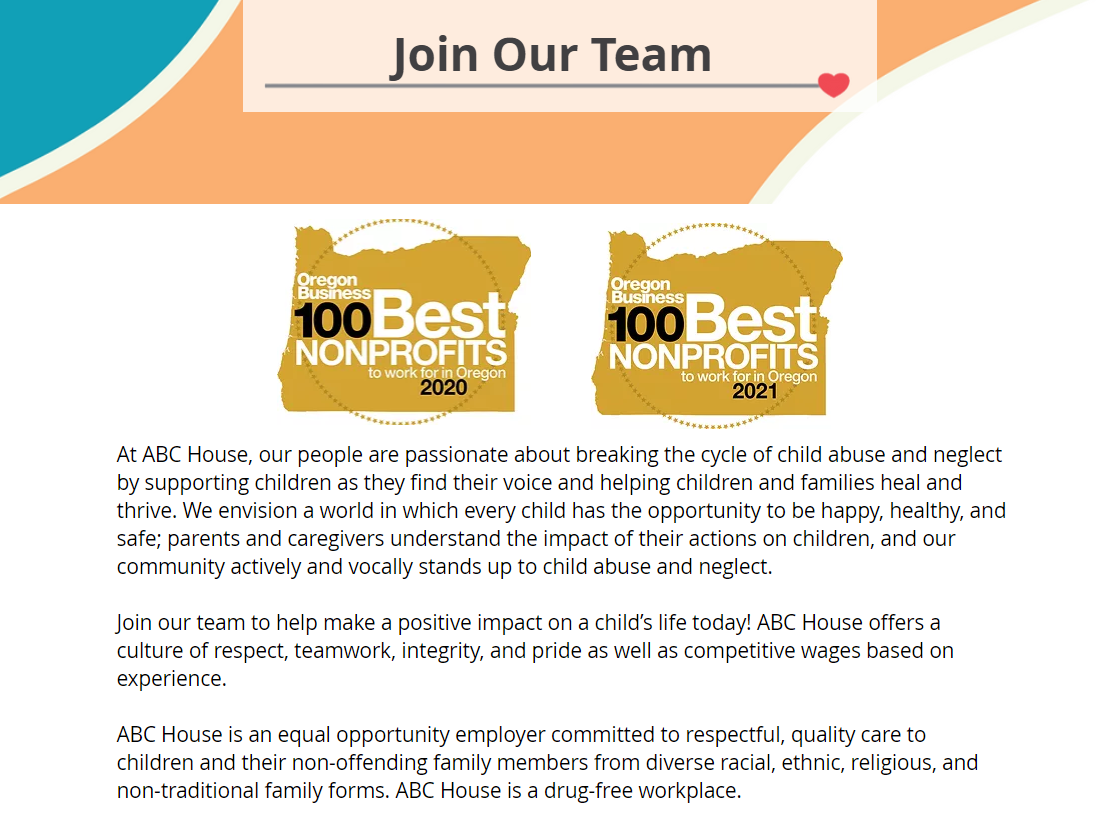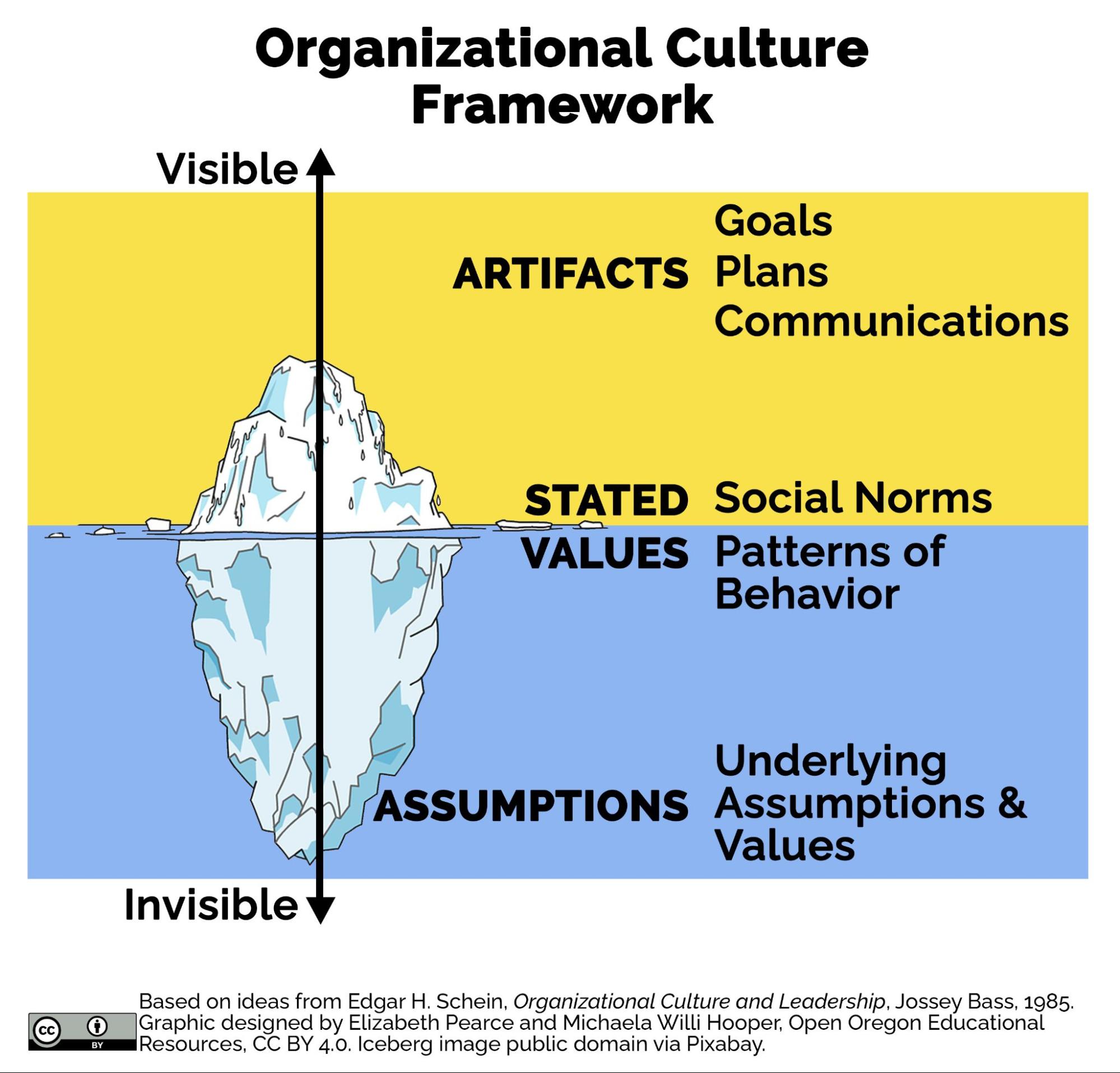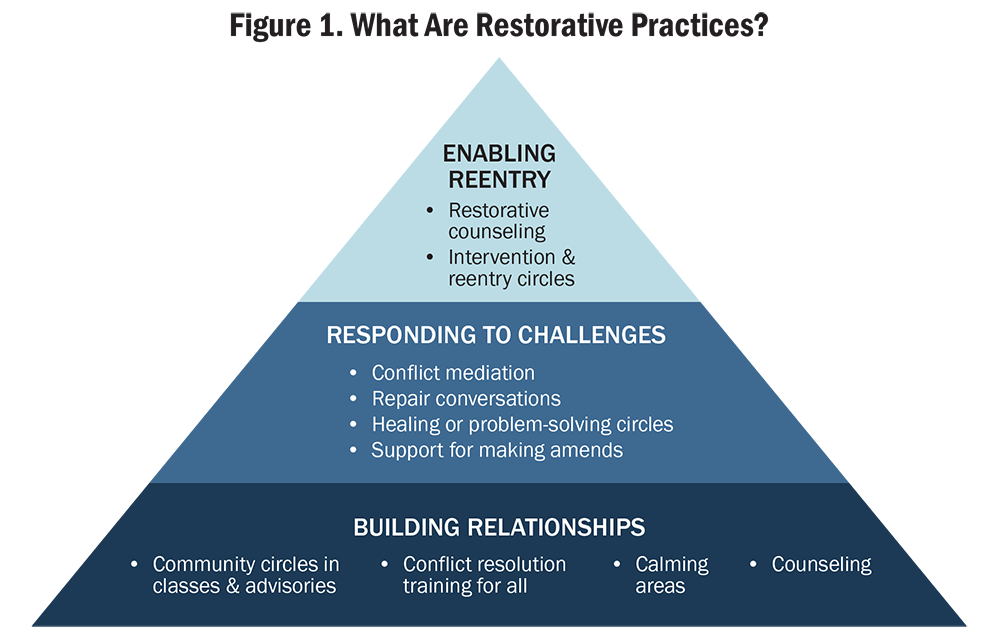10.4 Organizational Culture in Field Sites and Workplaces
Organizational culture refers to a system of shared assumptions, values, and beliefs that show people what is appropriate and inappropriate behavior in a particular agency or workplace (Chatman & Eunyoung, 2003; Slocum, 2005). These values have a strong influence on employee behavior as well as on organizational performance. Organizational culture is expressed implicitly, explicitly, or a combination of both.
It is an advantage to experience multiple field sites before obtaining a paid or full-time job. While organizational culture may not spring to mind as the very first criteria to consider, it can make a big difference to your overall satisfaction with the workplace, and to your stress level in particular. Observe and assess varied organizational cultures in a variety of settings before choosing a job or career. Organizational culture can be expressed subtly, and knowing what it is and how to look for it takes practice.
Culture, most often associated with family and social groups, describes the arts, traditions, social institutions, values, and beliefs that are shared and passed down through generations over time. While many traditions remain the same, others are adapted and adjusted by subsequent generations. So how does this mesh with a human services organization and workplace?
Formal Organizational Culture
Most workplaces express their organizational culture in the form of a mission statement, a vision statement, or core values. Organizational culture can be explicitly stated (e.g., in written policies, employee manuals and training, codes of ethical conduct, website forms, and instructions for clients), or it may be obvious only through experience and observation. For example, Brown Hope, a service and advocacy organization in Portland, Oregon, states its mission on the home page of their website:
Brown Hope is planting and nurturing seeds for racial justice and healing. We serve and mobilize communities in order to heal our collective soil from the poisons of our past and present, so our future roots can thrive.
Some organizations share other parts of their organizational culture publicly. For example, the All Because of Children (ABC) House in Albany, Oregon, states some of its values as well as its expectations of employees on its general recruitment page, as shown in figure 10.7.

Activity: Web Page Analysis
Analyze the ABC House web page, pictured above and linked here, by discussing the following:
- What are some expectations of the employees? Find the specific words that describe employee traits to define and discuss.
- What kind of atmosphere, or organizational culture, might you expect to work in at the ABC House?
Informal Organizational Culture
In contrast to the formal structures that are conveyed via written and electronic materials, there are less formal aspects of organization structure, such as the ways that employees relate with one another internally and outside of work, that may not be as explicitly communicated. Here are some examples of informal practices:
- How employees greet each other when they arrive or see each other for the first time each day
- How workers address one another (first name, last name, or with a title)
- Is the convention applied equitably across job and education levels?
- Are some people addressed by title and others by name?
- Typical ways that employees dress, even if there is not a formal dress code
- Does it vary by day of the week, job, title, or gender?
- How personal life overlaps with professional life
- What personal information is typically shared?
- What is kept private? Do expectations vary by job, title, ethnicity, gender, or sexuality?
- Are there workplace-based celebrations of milestone events such as birthdays, weddings, births, or deaths?
- Are there expectations or practices related to who is invited to celebrations outside of the workplace?
Shared values and social norms that are only known implicitly or are underlying assumptions will be more difficult to discern by any newcomer to the organization, which contributes to a feeling of being out of place. An organization with a culture of practicing the explicit sharing of values, beliefs, and behaviors will be a more equitable organization, one in which newcomers are more likely to feel that they belong.
Some of these practices may be evident to you when you interview at a location, but it is more likely that they will become apparent to you over time. Keeping organizational culture in mind will help you to evaluate whether or not this is a place that you would like to work over the long term and what you want to look for in future internship and work settings.
Organizational Culture Framework
This framework uses three elements for another way of looking at organizational culture:
- Artifacts: mission, goals, plans, and communications
- Values: norms and behaviors
- Underlying assumptions: unconscious, taken-for-granted beliefs; habits of perception, thoughts, and feelings
In figure 10.8, you can see that the underlying assumptions are the foundation and source for the values, actions, and artifacts (Schein, 1985).

One of the challenges that an organization can face is the fundamental assumptions not being congruent with the more visible aspects, especially if the organization is trying to change. The underlying assumptions need to be uncovered and exposed in order for the organization to develop, grow, and have true congruence with its values and artifacts.
Organizational Culture and Inclusion
How does organizational culture relate to equity,inclusion, diversity, and restorative justice? If we define equity as being sure that everyone has what they need in order to have similar opportunities, we must pay attention to the ways that any organization welcomes new people into the space and cultural structure. In addition, how people are oriented and included in the organization will affect their ability to adapt and willingness to stay. How are they oriented to the space and entered into the community or space in general?
If people new to the organization represent diverse groups from those who have typically held power, the organizational structure needs to be set up not to just include but to value diverse thinking and perspectives. The only way that diversity, equity, and inclusion can be institutionalized is if the organizational structure and culture is dedicated to these principles as underlying assumptions, stated values, and artifacts. If it is, diverse staff will be retained, and eventually this will facilitate the decolonization and diversification of the leadership.
Let’s take the example that many of you may be familiar with: the first-generation college student. Over the past few decades, increasing attention has been paid to acknowledging that a first-generation college student, the first person in their immediate family to go to college, will have different needs and strengths compared to a student whose parents, grandparents, or perhaps even siblings went to college.
These students often face different challenges than those faced by students who have family experience with college, and whose families typically support, encourage, or even require them to attend college. First-generation college students face the challenge of negotiating an environment that their parents may not be able to help them figure out, as well as the possibility that their families do not value a college education. They face challenges in learning the process and rules of college life as well as the difficulties of fitting in and developing a new social identity as a college student. If their family relationships are harmed by going to college, they need even more social support and relationship formation at the college itself (London, 1992).
The organizational culture at the college will be key to the first-generation college student’s likelihood of completing a degree. First-generation college students benefit from engagement in extracurricular activities and connections with peers (Demetrio et al., 2017). For example, if the college staff and faculty have underlying assumptions and understand the typical challenges faced by first-generation students, they may perform a number of activities (artifacts), such as:
- fostering the transition from high school to college with one-on-one relationships
- creating community among students in classes
- providing extracurricular activities where students can build relationships with other first-generation students
- creating time and space to listen to students who are struggling with their family relationships or social identity (Ricks & Warren, 2021)
If their underlying assumptions do not align with values and artifacts that support the integration of first-generation students into campus life, then it is less likely that students will persist and graduate. For example, if staff and faculty have underlying assumptions such as, “It’s tough for everyone. You can’t provide special services to some students. It’s not fair,” this belief will affect the organization’s success with implementing strategies to diversify and decolonize education. As discussed in Chapter 2, education needs to intentionally address inequities in order to actively include typically marginalized communities in leadership positions.
Another way to foster inclusion is to support the ability of each person to express themselves authentically. The next section discusses an emerging practice that some organizations are formally adopting to support diversifying and decolonizing social services.
Another group of students impacted by many of these same concerns are those who are coming back into the field after a period of not working. This could be due to many reasons, primarily raising children, being caretakers for older adults or older children needing physical and mental health support, needing a career change, coming out of retirement, or wanting to gain some additional certification or skills for their current careers. The reasons are vast, but the support needs can be similar, such as the need for community and help to provide a transition from one identity to another. These students are sometimes called nontraditional students, but in reality a student does not look one way. We call them students.
Restorative Practices within the Workplace
Restorative Practices (RP) is an emerging social science to many White people, but it evolved from ancient practices. RP studies how to build, strengthen, and repair relationships among individuals, as well as connections within communities. The practice focuses on building connections, accountability, and commitments through participatory learning and decision-making. Specifically, restorative practices can provide some justice to people who have been harmed via systemic oppression.
RP is also connected to Restorative Justice, in Chapter 3. While more preventative in nature, restorative practices has emerged from Restorative Justice, which is an intentional way handling an offense and involves three stakeholders within an organization or community: the person(s) who has offended, the person(s) who were harmed, and communities of care and reconciliation (Wachtel, 2016). Restorative Justice has roots in ancient and Indigenous practices employed in a wide variety of cultures, from Native American and First Nation Canadian to African, Asian, Celtic, Hebrew, Arab, and many others (Eagle, 2001; Goldstein, 2006; Haarala, 2004; Mbambo & Skelton, 2003; Mirsky, 2004; Roujanavong, 2005; Wong, 2005).
Restorative Practices are becoming increasingly common within many professions and workplaces related to human services, including criminal legal system, education, mental health, social work, and public health. Two restorative practices used in human services-related fields include Family Group Decision-Making (FGDM) and Family Group Conferencing (FCG). These were originally envisioned as family empowerment activities, such as when the native Maori people in New Zealand started using FCGs to address their concerns about the number of children being removed from their homes by the government and court structures (Doolan, 2003). Those practices have evolved to include communities of care that foster increased social capital and connections with families.

Restorative practices are most effective when they are used holistically to build relationships within organizations or within communities. This means using them in a proactive way and not just when harm has occurred. Structures that support the building of connection through authentic communication and social capital that is shared by all members of the community can decrease the amount of harm that occurs (Davey, 2007).
This is a gentle reminder that these practices are not something you can do in isolation once or twice as a replacement for toxic work environments. It is a way of framing a whole systemic approach to how one functions within that system—a culture of the system.
Licenses and Attributions
Open Content, Original
“Organizational Culture in Field Sites and Workplaces” by Elizabeth B. Pearce is licensed under CC BY 4.0. Revised by Martha Ochoa-Leyva.
Figure 10.8. “Organizational Culture Framework” by Elizabeth B. Pearce and Michaela Willi Hooper is licensed under CC BY 4.0. Based on ideas from Edgar H. Schein, Organizational Culture and Leadership, Jossey Bass, 1985.
All Rights Reserved
Figure 10.7. Webpage screenshot from abchouse.org/careers is included under fair use.
Figure 10.9. What are restorative practices by Learning Policy Institute is licensed under CC BY NC 4.0.
system of shared assumptions, values, and beliefs that show people what is appropriate and inappropriate behavior in a particular agency or workplace.
shared meanings and shared experiences by members in a group, that are passed down over time with each generation
a professional field focused on helping people solve their problems.
the socially constructed perceptions of what it means to be male, female or nonbinary in the way you present to society
social identity based on the culture of origin, ancestry, or affiliation with a cultural group
a person’s emotional, romantic, erotic, physical, and spiritual attractions toward another in relation to their own sex or gender.Sexuality exists on a continuum or multiple continuums
a credit class in which students apply theory to practice by using what you have learned in coursework in a real world setting with a supervisor/mentor who is invested in the student’s growth and development.
being “real”; actions in line with values and beliefs.
provision of what each individual needs in order to receive and obtain equal opportunities.
an alternative approach to criminal justice that centers the survivor, taking into account what they need to experience healing. It also involves the participation of the perpetrator, requiring them to recognize the harm they did in the process of holding them accountable.
the first person in their immediate family to go to college.
an academic rank conferred by a college or university after completion of a specific course of study.
the acts of identifying systems of oppressive colonization, dismantling historical records that emphasize the dominant culture’s story, and striving to effect power structures so that they are shared more equitably.
strategies that build, strengthen, and repair relationships among individuals, as well as connections within communities.

